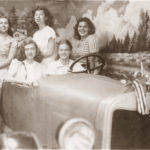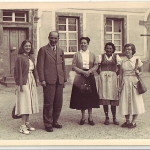Day Two:
I had at first been apprehensive about sleeping, as I discovered that my room was essentially over the kitchen, which meant that I would be sleeping to the sound of dancing pans as the kitchen crew cleaned up. Normally I would be up and complaining to the management, asking for a new room. But this was not normally–I was traveling alone in Europe for the first time since 1981, and I admit I felt a bit lonely. The kitchen crew had clearly been asked to keep the noise level down, and soon the muffled voices, laughter, and lingering but faraway chimes of metal lulled me and I fell asleep well before the kitchen crew called it a day.
The always patient and helpful Tala let me sleep in a bit before she picked me up to go to her place in the London-meets-Surrey area. There I encountered my “den” for the next few days–a living room in surprisingly welcoming hues of white and black with so many photographs everywhere that I could have been at the home of a Cuban relative, but, I admit, with much better taste. There I encountered the welcoming black sofa which took me in its arms and made it difficult to get up. Not that I would want to, given the way Tala kept me well laden with turkish–I guess, really Iraqi coffee (I really miss the coffee) and cookies and turkish delight. I’m surprised the sugar high didn’t bolt me through the room and into the wall, but with that sugar intake there was no way I would fall into a jet-lagged stupor.
We decided that the main day would be informal, but, just as Joan always seemed to bubble up into stories, so today was Bedia day. I mentioned to Anissa that I really knew nothing about Bedia–all I knew is that she would call occasionally and my grandmother would answer the phone and be on the phone and on the phone and on the phone, then would eventually say to Mami, “Maria Teresa, es Bedia,” and my mother, from the kitchen would say something like, “Ay no, Bedia? But I’m making dinner!” So the only thing I learned about Bedia as I was growing up was that Bedia lived in Los Angeles and that there was no such thing as a short conversation when she called.
Maybe because that’s all I knew about her, I always wanted to know more, so, as I settled more deeply into the welcoming black sofa, I realized with pleasure (that came from the sugar-saturated coffee as well), that this would be Bedia day, and I soon realized that Bedia was all and more than I had hoped.
I learned that Bedia is not a central character of this narrative–she did not go on the trip to Europe; but, of course, that never stopped Bedia. She is one of the protagonists of this narrative nonetheless.
The Europe trip, it turned out, would not have been possible without Bedia, for it was Bedia who convinced Anissa to come to Vassar, and, hence, meet my mother and Joan. After I’d heard all the Bedia stories (a book project in itself), I was not surprised–Bedia was the idea person, the initiator, the person who never took “no” for an answer; above all, Bedia was the rebel, and, as the day’s worth of stories continued, and my admiration of Bedia increased, I also began to feel a bit sorry for Bedia’s parents.
After all, once Bedia arrived in the States, she announced to her family that she was not returning, and when they would not accept her decision she found one way after another to prolong her stay, until her family gave up.
How Bedia Stayed in America
Once upon a time a young Iraqi woman decided that she would go to college in the United States. The fact that a good chunk of the world was at war or getting over a war did not seem to dissuade her. She was a young woman of strong imagination and determination; to get to Ameria she told her father that she was bothered by the fact that she had something of a moustache, and that she could only get rid of it if she went to a specialist in New York City–the hub of medical specialists. She had dreamed of New York–a place of wonderful foods, strange noises, and above all a place where she could do what she wanted to do. Her father accompanied her on the trip to protect her from its strange and unusual inhabitants. But this young woman had already decided that she was not going back to Iraq, and she found reasons to stay.
When her moustache disappeared, she firmly bid her father adieu, bid New York adieu, and left for Vassar College–then one of the most prestigious colleges for women in the United States, one which–with great foresight–encouraged international students to apply. Less exciting than New York, Vassar nonetheless held strong appeal for Bedia, who found there a group of intelligent, attractive, lively women like herself from all over the world, although especially from the United States.
At Vassar, first year students were not supposed to have cars, so at Vassar, Bedia bought a car. Having encouraged her probably more hesitant and prudent friend Anissa to drive to California with her, she and Anissa promptly drove West, stopping occasionally to absorb key moments of the American landscape. Anissa showed me a photograph of herself with Bedia at the foot of the famous redwood tree in Yosemite (the one you can drive through). I remember the two young energetic women with beaming smiles in the photograph (note to self: see if you can get a copy of the photograph), but I don’t remember the car. I don’t think it was a convertible, yet when Anissa told me of the trip, I could only see two young women driving fast, very fast in a convertible, dark, lush hair streaming behind them.
Anissa added that she and Bedia made that trip twice.
* * *
It is amazing–given the many places Anissa had traveled in her life–that it is Anissa who had so many photographs of her time in Vassar. I was taken by lovely, faded photographs–so faded that it was hard to distinguish facial features–of Anissa with Mahaut de Perthuit (then Mahaut de la Noue) at Jones Beach in 1947. I remembered Jones Beach–Daddy had taken us there a few times when we were kids. Once, when there was a warning up about the strong current, I was taken up by the waves and for awhile I lost all control. The feeling wasn’t even panic; it was an awareness that I had been grabbed by the surge and that I might get swept up never to return; then the wave finished its surge and I was swept back with force to the beach with nothing but a scraped knee as a souvenir. The photograph at Jones Beach I saw were of college women on their days off. Bleached with age as the photographs were, they still reflected the happy, carefree looks of young women on vacation. I saw a few photographs of Mahaut with Anissa and Bedia and I was struck by how Mahaut looked like Katharine’s friend, Anne Barrand. I had never seen Mahaut look so carefree; I’d only seen her as a mother. My earliest memory was of her in her wonderful flat in Paris near the Bois de Boulogne, in that lovely dining room with the orangeish cloth on the walls. She seemed very serious to me and formal, so that, actually the one I remember best is her Moroccan cook–who, simply by serving me seemed so friendly and welcoming and whose cooking introduced me to the wonder of chicken cooked with grapes. You have to remember that I was raised in Potomac Md., at the time when its only restaurants were the lunch counter at the drug store and Normandy Farm, which (despite its wonderful popovers), even in its heydays, never tasted like the kind of food you can actually eat in Normandy.
* * *
But Bedia, it turns out, had a rival–Mme de la Noue, Mahaut’s mother. The many references to Madame de la Noue at first made my head spin. When I thought of Mme de la Noue, I thought of the striking red-headed mother of my friend Christine de la Noue (Mahaut’s goddaughter), or of her mother-in-law, the white-haired Mme. de la Noue in Maganosc, in the South of France, who enjoyed life’s small things, especially the act of feeding the cheese crusts to her dogs as dinner came to a close. But I did remember meeting Anissa’s Mme. de la Noue once, in about 1981 I would guess. I was having lunch with Mahaut and Christine in the Paris apartment, and Mahaut called out “Maman, c’est Terry, la fille de Maria Teresa.” At that point a wiry woman who had been mowing the lawn came in and covered me with hugs and kisses as I tried to remember who she was.
Someone at some point had tried to tell me that she was no longer in her full, vivid, mind–but this woman who was hugging was definitely all there. I was to hear even more about Mme. de la Noue when I reached France.
***
But let us not forget Joan, who definitely does not want to be overlooked. If I heard a lot about Mme. de la Noue, and even more about Bedia, remarks about Bedia seemed always to be accompanied with comments on Joan. When Mami came up, it was almost as if she was an appendage to the peppy, ironic, vivacious, never quiet Joan.
One of the early stories I heard about Joan was that she was always embarrassing Mami on the trip to Europe. The Europeans, after all, were just getting over the post-war shortages, rations, and even near-starvation. They simply couldn’t understand Joan, whose main response to most questions seemed to be, “No thank you; I’m on a diet.” Anissa’s response was, “Joan was always on a diet. At lunch she would just order clear soup.”
Joan will be continued; it’s time to post.



Speak Your Mind